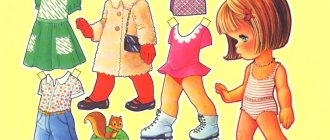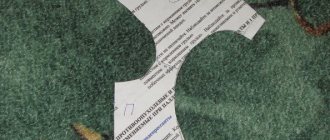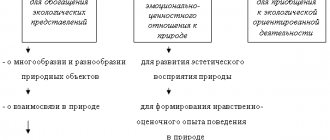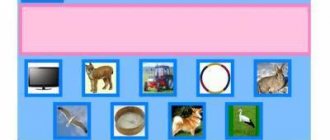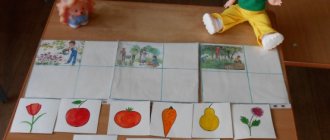How to teach a child to assemble a three-seater nesting doll?
Typically, children learn to assemble a three-person nesting doll between the ages of 1 year 9 months and 2 years. We will need three nesting dolls with a difference in size of 3-4 cm, for example, a small matryoshka can have a size of 4-6 cm, a large one - 7-9 cm, a large one - 10-12 cm). If your child has never played with a nesting doll before, it is best to use it as the smallest one-piece nesting doll in the set.
If the child easily copes with this task, complicate it with matryoshka dolls that differ from each other in height by 1.5-2 cm.
Step 1. Give your child three nesting dolls and ask them to show you the biggest one, the smallest one, the smallest one. Let the child study them carefully. Ask him to line up the nesting dolls in a row: first the small one, then the big one, then the big one.
Step 2. Then invite the child to open the nesting dolls and ask each matryoshka to give it a “skirt” (put the bottom of the nesting dolls - their “skirts” in front of the top). If you have difficulty, show yourself how to do it.
Tell them that the nesting dolls really want to try on their “skirts” and ask the child to help them. “Where is our skirt for the largest nesting doll? Let's help and put a skirt on the matryoshka. Where is the skirt for the smallest nesting doll? Choose a skirt for the smallest nesting doll. These are beautiful nesting dolls!”
Step 3. Then ask the child to “hide the nesting dolls” (i.e. collect the nesting dolls). It may not be easy for your baby at first, so he will need your help and a show. Sometimes you may need to hold her hand and perform the desired action with your child's hand.
In the future, repeating the game with nesting dolls, the child will become more independent. It should be taken into account that young children very quickly forget what they have learned, and therefore more repetitions are required (at least 2-3 times on the same task).
Next time, you can conduct a lesson with a matryoshka a little differently, for example like this:
Step 1. Show the three-seater matryoshka doll and shake it. What's rattling? Take the central nesting doll from the nesting doll and place it next to it. How beautiful and smart they are! Ask your child to shake the large and small matryoshka dolls. Oh! It turns out that something is also knocking inside the baby! What is this? Let the child take a smaller doll.
Step 2. Place three nesting dolls in a row - large ones
, small , and between them – on average. Ask your child to show you where the big matryoshka is, where the small one is, and where the middle one is.
Step 3. Assemble the nesting doll. Firstly, you need to put a small one in the middle matryoshka (children often make mistakes in the assembly sequence, so clarify this point: which nesting doll should be hidden first). Show the 2 remaining nesting dolls. So, open the big one and put the middle one inside.
What else to read: Didactic game for middle preschool children “Dangerous Objects”
Step 4. Give the child a toy for independent play. Let him take the nesting dolls apart again, arrange the dolls in a row, and then put them in one - “hide.” Help me match the pattern on the matryoshka doll.
Didactic game "Matryoshka" in the younger group
The purpose of the didactic game “Matryoshka” is to teach the skill of working with a three-dimensional object, selecting and combining its components. This game, like the others, reinforces the idea of a national souvenir toy and fosters respect for folk art.
For the lesson, you need a split toy about 10 cm high. The teacher demonstrates it and explains how it opens to remove the next toy. When all the nesting dolls have been removed, the teacher shows the preschooler how to correctly assemble them in reverse order, and how to close the toy so that its upper and lower halves match the pattern on the apron.
Games with matryoshka dolls for kids
Matryoshka dolls are useful. First of all, this:
- Development of sensory skills (vision, hearing, touch). The child gets acquainted with a variety of sizes and shapes. Using the nesting doll as a rattle, we develop its auditory perception.
- Speech development, attention, logical thinking.
- Development of fine motor skills, coordination of movements.
It's time to share educational nesting doll games with you.
We look for and show the body parts of the nesting doll
First, get to know the nesting doll, describe it, admire its beauty: “This is a matryoshka. Her name is Matryosha. How beautiful! What eyes he has, what a nose, what a mouth, what cheeks! What a gorgeous scarf! The nesting doll has eyes. Where is Vasya...?”
Opening and closing the matryoshka doll
Show your child how to open and close the nesting dolls and how to remove them from each other: “What a heavy nesting doll. What's in a nesting doll? What's thundering inside a mother? Knock-knock, matryoshka! Knock, knock, knock, bye, show us your secret!”
The boys are very curious and are looking forward to continuing. Open the nesting doll and smile every time and be surprised by what you see:
"Oh! Yes, there is a smaller nesting doll. What's there? The matryoshka is even smaller... And here is the smallest nesting doll. There are no more nesting dolls!”
After you have completely disassembled the nesting dolls, assemble them again into a larger one.
Looking for surprises
Children love moments of surprise. You can hide anything you want in a nesting doll: beads, sweets, ribbons. The child will definitely be interested and want to open the nesting doll if he sees a piece of tape peeking out. Fill the nesting dolls with different materials, compare sounds, master the concepts very little. Another game option: teach your child to determine by ear where an object is hidden. We can say that one of the nesting dolls ate a candy, but which one needs to be determined by shaking each nesting doll:
Our dear matryoshka, I wanted to eat it! Mom didn’t listen, but she ate the candy. Where are you, our matryoshka, do you have porridge?
Having found the desired nesting doll, ask the child to wave it with his finger and “feed him porridge.” At the same time you can feed the rest of the nesting dolls. Inside the nesting dolls you can put a different number of objects (for example, plasticine balls). For example, the nesting doll ate 1 candy, the second - two, the third - three. Count the number of items along with the crumbs and match them with the plastic numbers (1,2,3).
We are looking for halves of nesting dolls
We mix the parts of the nesting doll and ask the child to assemble the matching halves. Important! Let your baby make mistakes. Let me put some halves on top of each other, try to stack them, stack them on top of each other, etc. In the course of such actions, he will draw many important conclusions. Let him play as he wants. From time to time I show how to find and connect matching halves.
Comparing nesting dolls
“The nesting doll is big, but this one is small.” You can speak for the nesting doll in several voices:
“I am a big nesting doll” (in a quiet voice). “And I’m a little nesting doll” (loudly) “Wow! Look how many nesting dolls there are. And here is the nesting doll.” We teach older children spatial orientation, with the help of nesting dolls we master concepts such as: many, few; right left; front back; above under; behind-front.
What else to read: Didactic game “Guess the sport.” presentation on physical education
Find by description
When the child has already learned to play with matryoshka dolls and distinguish them by their main characteristics, you can assign him simple tasks: “Give me a doll that is bigger than this one” “Give me a matryoshka doll that is smaller than this one” “Give me the lower nesting doll of this one “I am a doll in a blue scarf / in a red sundress” “Give me a medium-sized nesting doll” “Give me an open nesting doll” “Give me a nesting doll that rattles” You can also come up with the names of the nesting dolls and ask each one to perform some action: let Masha’s nesting doll jump, Katya’s lie down, Dasha’s will sing a song.
Playing math games
A set of nesting dolls is perfect for role-playing games. You can play daughters - mothers or in medical school... It’s easy to build a table and chairs from cubes and have a tea party. All that remains is to seat the guests and place a plate of treats and a cup in front of each person (individual correspondence). By the way, three-year-old children can complicate the game by asking them to give the nesting dolls plates of different sizes. Matryoshka dolls can be put to sleep (on rectangular beds of a suitable size), rolled into a stroller, in a car, or taken for a walk. To collect nesting dolls for a walk, you need to line them up in a row. Matryoshka is big, for example, mother, and the rest are daughters of different ages. Either the big nesting doll is a teacher, and the other nesting dolls are children in kindergarten. If the child gets confused when lining up a row, place two nesting dolls next to each other and determine which one is taller together. If you have two sets, you can play that the babies are mixed up, and you must place them in pairs, that is, large, medium and small nesting dolls are related to each other (that is, find the same ones). Build nesting dolls (large and small) from bricks or builder and, to your surprise, you will find that a large nesting doll does not look very good in a small house. There are many options! Every day you can stage a new fairy tale.
Painting nesting dolls
In any craft store you can find wooden blanks and paint them with your child. Remember, the main thing is to enjoy the process. Be sure to praise your little one’s creativity!
We arrange the nesting dolls according to the diagram
Schematically drawn nesting dolls (large, medium and small) in different sequences, and the child positions himself. At the same time, we are learning the concept of object projection. We show the child that if you put on a matryoshka doll and search, you will get a pear, and if you put on and search, you will get a circle. You can play that the pears are cribs, and the circles are chairs on which you need to put the nesting dolls.
So many useful educational games with nesting dolls! The matryoshka will be of interest to your baby for a long time, so be sure to buy this wonderful toy. It will not only decorate the interior, but will also help make your child’s free time as productive as possible.
Didactic game “Assemble a nesting doll”
The game, intended for younger preschoolers, teaches how to compose images according to the principle of puzzles and identify the component parts. The lesson requires cardboard images of nesting dolls, cut into several arbitrary pieces.
The player tries to assemble an image from parts. If there are several children, the game can be made competitive: the winner is the player who collects his picture first.
Running errands for a matryoshka
This active competitive game promotes general physical development and teaches one to navigate in space.
Children sit on chairs in a row. The teacher sits against the opposite wall, holding a matryoshka doll in his hands. Gives the command: “Here, to the nesting doll!” Children are running. The one who runs last loses. Then the teacher commands: “Now run back!” The children rush to their chairs. And so on several times until the winner is determined, who was the first to reach the toy more often than others.
Didactic game “Dress up the matryoshka”
The game teaches you to see beauty and fosters a love of creativity. The goal is to learn the skill of laying out patterns according to a template.
For the lesson, you need large images of nesting dolls without patterns on the apron and scarf, as well as small template images with different decor options. Separately, it is necessary to cut out multi-colored floral patterns and geometric shapes with which children will decorate aprons and scarves. The game task for the younger group is to lay out patterns according to the provided templates. Older children can be encouraged not to use templates, but to come up with a beautiful pattern themselves.
Matryoshka, show yourself!
The goal of the game is to develop reaction speed, observation and the ability to act in accordance with the command.
For this activity, you need a small separable doll so that it can be conveniently placed in a child’s palm. Pupils sit on chairs forming a circle. With their hands behind their backs and palms open, the children watch the teacher. And he walks along the circle, bends over to each child, and quietly places half of a nesting doll into the palm of the two players.
Then he gives the command: “Matryoshka, show yourself!” Players who receive a toy in their hand must jump up from their seats and jump into the middle of the circle so that their comrades do not have time to stop them. The task of the other players is to guess who has the hidden parts of the toy and to catch these guys.



